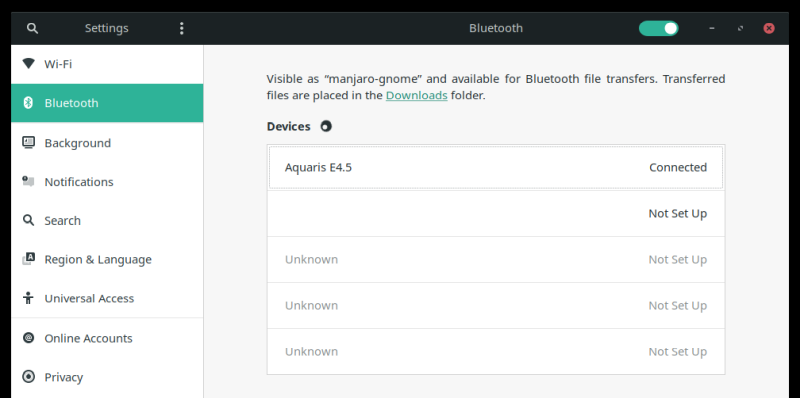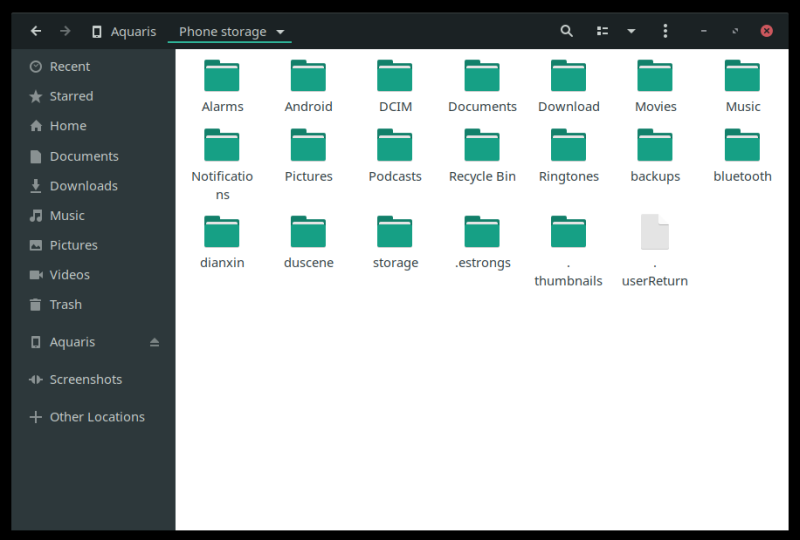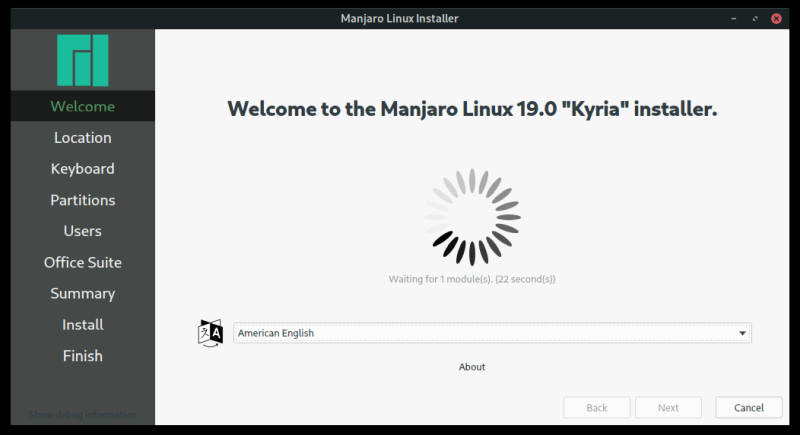Flashing my dope cool nerd badge. Agent Dedo, at your service. Why? Because I’m testing an
Arch-based distro again. Now, over the years,
Manjaro has done a great deal to distance itself from its
sacrificial altar roots, and now caters to people who prefer things more desktopy. That doesn’t meant
it’s all 4% milk and yak butter from here on, oh no. But it’s steadily improving, and my impressions of
yesterversion were jolly.
But then, in the last few tests, I tried Plasma, Xfce and Cinnamon editions – not Gnome just yet.
While I think it’s an unnecessary toll on resources maintaining four different desktops, perhaps we
might be pleasantly surprised. After all, Manjaro has always managed to sneak in cool features amidst
the nerdery. My test box be Lenovo G50, with its multi-boot boogaloo. Let’s commence.

Live session
First, I selected the nonfree driver in the boot menu, as using only the free one caused me
trouble in the past. So I went with the most permissible option. Quick and clean boot, and then you’re
in a desktop, all green and gray, the signature colors of the Manjaro family, somewhat like Mint, but
then different.
At first glance, things were in order, reasonably pretty and tidy, although I am not sure what that
Caffeine thing is meant to do. Then, the contrast can be a bit better, fonts wise, although overall,
the clarity is pretty good. Definitely among the better results in the Linux family.


Network connectivity
Average. Wireless and Bluetooth worked fine. Samba sharing was ok, but only if you connect directly
to a host. The file manager Windows network option threw a silly error. Similarly, the printing applet
couldn’t find any devices, either the Wireless or the Samba one. Not the best record we’ve seen,
mind.



Whence this weird alpha border cometh from?
Multimedia playback
It worked, but I’m surprised by the choice of the application(s). Video plays in Videos, and it uses
its own hard-coded dark theme, and not what the system has. An old problem. Music, you get something
called Lollypop, and it’s another Linux music player with some nice flashy points side by side with an
incomplete design. For example, the current song title is placed inside a weird little box with odd
padding. If you switch to it, then there’s only a time counter, no slider, so I’m not sure how one
actually skips if they want to. Here, the song name is invisible against the text box – unless you
switch into Party mode. Overall, VLC for all would have been a much better, simpler choice.



Smartphone support
Not as good as it should be. Overall, Gnome has no woes with any one of the major brands – since the
Windows Phone demise, I’m only doing Android and iPhone. Well, it didn’t work as planned. First, you
get a phone icon pop up in the Launcher when you connect a device. Clicking on it does nothing. You
need to right-click, which sort of ruins the whole idea. If you do right-click, not much happens
either.
Android mounted fine, but
iPhone 6S with the latest iOS update did not. Files only showed
iPhone Documents and not the DCIM folder, and trying to access the Documents threw an ugly error. Seems
like we have another regression, and functionality cannot be taken for granted. As it happens, I’ve
been doing some more Plasma testing recently, and I encountered a bunch of issues with phone
connectivity there, too. But that’s a story for another time.


Other observations
Manjaro comes with some nice touches. For instance, Files > right-click, you can create new
files. Golly. The system suspended itself after 30 minutes of inactivity, even with the infinite wall
socket power on, and the resume was quick and painless. No password needed, though.

Empathy didn’t work. I launched it, it presented me with an account creation screen, and that was
it. The + button was unresponsive, and I had to kill the application. Perhaps things will work better
once the distro is installed (if), but it looks like another colorful addition that serves no
purpose.

Indeed, looking at the app selection, it’s very random. Very eclectic. You get a lot, but then, I’m
not sure if this is entirely a good thing. OpenSUSE Image Writer, uGet, Manjaro Settings that uses its
own fuzzy fonts and styling and looks totally lost and out of place, Software Token, Kvantum, and so
on. I’ll try to make sense out of this later on, if everything works smoothly.



Notice the fuzzy font and whatnot.
Finally, if you search for “print”, the two results you get first are Screenshots and HP Device
Manager but not the Settings menu where you’d configure the printer to begin with. Not sure if this is
a generic Gnome issue, or how Manjaro does search, but it needs to work better.

Installation
For some odd reason, with most Arch-based distros, you need to “wait” for some module to load when
you launch the installer. No idea why. The partition discovery was super-quick, but you get no labels,
so you need to know what resides where. The timezone step also lets you use separate time, language and
number locales, which is really nice, so you’re not forced into any silly regional dialect for
multi-zone languages.


Then, there’s the Office suite selection. A nice touch – but the interface is inconsistent. Three or
four different fonts, some clear, some ultra-fuzzy. Feels like random pieces thrown together.

The installation completed successfully – but it took a long time. Yup, the GRUB part,
where the eight different operating systems all need to be chained together, that was the culprit
– or rather, it exposes how inefficiently GRUB does its update. But then, the process was even longer
than most other distros that waste time discovering partitions first. All in all, 90 minutes, which is
a ridiculous amount of time, and nothing to do with system resources.

Using Manjaro
The distro booted fine. Clean splash, no ugly text messages. The Wireless settings were preserved,
and the system popped a notification about updates right away. A reasonable start, one must say.

Package management & updates
I’ve always felt this part of Manjaro was the weakest link. Seems a bit improved here. The GUI looks
a bit more presentable, it’s definitely faster. Of course, pretty screenshots and user reviews and
whatnot would make this into a proper store experience, but overall, you get the necessary
functionality. If you’re not happy with the defaults, there’s AUR for you, and bauh, so you can load up
your system like you load up carbs ere a marathon.

Top and right margins, tsk tsk.


What sound do pirates make? Aurrrr!


Why two versions of Steam, pray?

Different styling from the rest of the system.
Applications
Not bad, but not good either. First, as I mentioned earlier, the collection is just all over the
place. Second, you get no hover notifications in the app grid menu, so truncated text doesn’t really
help you figure out what the software under your mouse cursor is or what it does. Third, some of the
stuff is simply broken or badly configured. For instance, Software Token and LSHW. Both these threw
errors that don’t really have proper solutions.

No window decoration. Run stoken import where?

Not even a title for LSHW – no idea what this app is.
Ignoring these, the rest of the stuff is reasonable. Again, there isn’t a clear theme what the
software is meant to do, and some of the choices feel random. However, you do get Firefox, LibreOffice,
no more Microsoft Office Online, Steam, Timeshift, a whole bunch of utilities, and then some.

Resources, performance, responsiveness
Overall, Manjaro 19 Kyria was surprisingly nimble. The idle figures show CPU utilization of about
2%, memory usage is just under 1 GB, but the system is fairly quick. Responsive, snappy, and with no
obvious visual delays or quirks that often happen in Gnome desktops. Not sure if this is advancement
a-la Gnome pure or some wicked tweaks the Manjaro team has introduced.

Hardware compatibility, stability
No complaints. Stable, robust, no errors at all. Everything worked fine, suspend & resume, Fn
keys, webcam, you name it. If not for the smartphone connectivity issues mentioned earlier, this would
be a stellar record on the plastic, metal and semiconductors side.
Battery life
Often, resource usage numbers don’t correlate with how frugal the system is. Normally, Xfce and
Plasma lead the pack, but some Gnome distros do manage to be rather lean, like say
Fedora 31. Now, with the battery capable of charging only about 60%, and
the charge level at 68%, we get 80 minutes at 50% brightness and low usage. This translates to about
200 minutes worth of battery life if the cell was brand new. Short of four hours, which is where my
happiness endocrines kick in. So no kick in.

Other things
What I found super-annoying is that come the evening hours, some useless color-shifting app
activated and turned my desktop jaundice-yellow. I guess this be part of that whole bad-light bad-eyes
fad, just like dark themes. Don’t want – I sit in a brightly illuminated, color-calibrated 6500K room,
and there’s no need for any distortion of the nature-intended spectrum.
On the other hand, a really cool thing – Layout Switcher. Similar to Zorin, but then ever so
slightly different. Also, better overall contrast and clarity In the end, I didn’t feel any need to
customize the distro. It’s pretty and presentable, so I only did some basic changes, like the wallpaper
stuff (some improvements here, too).



Conclusion
Manjaro 19 Kyria is a solid, rounded distro – at least, the Gnome version is. But I presume results
are quite similar across the board. Surprised, I am, as I was expecting something less polished. I do
have to say that Kyria has some nice points, it’s colorful, stable and rather friendly, and the package
management is a tad better than in the past.
However, it does suffer from oddities. The application collection is too wild and undefined, some
software has been added without any consideration to the esprit-de-distro, smartphone support can be
better, and more battery time would be nice, too. Maybe this is Manjaro transforming from a leetbox to
the Average Joe consumer thingie, or maybe this is a neverending part of the cosmic randomness called
Linux desktop. We shall see. For now, testing, you ought. Grade? 5/7, I’d say. On a serious note, 8/10.
I shall be keeping an eye on them other flavors. Take care.
